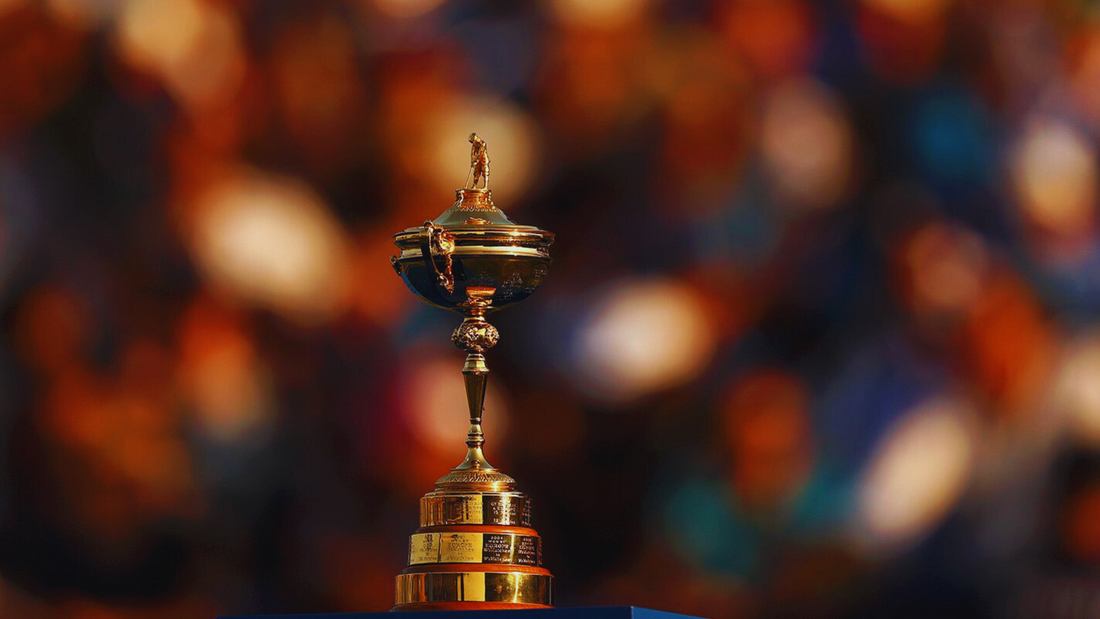
Why the Atmosphere at The Ryder Cup Feels Different
For 51 weeks a year, golf is a handshake and a hushed voice. But when the Ryder Cup shows up, the sport drops the library rules and for one week, leans into a vibe that is more Happy Gilmore. The marshal’s paddle says QUIET, but nobody’s listening.
The volume is already a living thing. Cameras up, staredowns, chest-thumps, smart chirps and a crowd that pushes.
This isn’t a character break. This is golf revealing its other face, the one built for team colors, match-play nerves and winning.
Competition has always been a factor in the international events but the tension for the Ryder Cup has always hit a little different. My favorite example being the dust up at Brookline in 1999.

The U.S. trailing Europe 10–6 on Saturday. U.S. Captain Ben Crenshaw had “a good feeling,” but the lightning strike hit when Justin Leonard nailed a 45-foot birdie on 17.
Celebrating the massive comeback, Justin was quickly joined by caddies, wives, five U.S. players and even officials. All-in-all, about ten people jumped, screamed with delight, hugged and …trampled all over the green.
All while Spanish player, José María Olazábal, still had a ~22-foot putt that would have extended the match.
Vice-captain Sam Torrance, condemning the behavior as disgraceful, adding “The Americans should be ashamed of themselves… Olazábal still had a putt which could have led to us winning the Ryder Cup.”
The Ryder-Cup-Rowdy got turned all the way up again at Hazeltine in 2016. The heckling of Danny Willett, for his brother’s viral essay and prevalent chants like “Sergio, you suck!” led to an on-course intervention from U.S. vice-captain Tom Lehman. Proving the Cup encourages volume, but will enforce a boundary, a fan was ejected after a crude shout at Rory McIlroy.
McIlroy called it a “tough environment” that demands total focus, adding he wasn’t “fazed by anything said by the crowd” or “anything the U.S. throws at us.” Putting his words to action just hours later in sport’s best modern duel vs. Patrick Reed on the 8th. Each of the players traded bombs and bows and finished a knuckle-bump.
That’s the Ryder Cup: chirp, answer, then shake.
Bethpage Black, lovingly called the people’s monster, has set the dial to 11 this year. This place has always tested swings. Now it’ll test composure.

For Ryder Cup 2025, the first tee has been pushed forward and wrapped in a coliseum of roughly five thousand seats, a purpose-built outdoor chamber where chants can stack up and nerves have a tendency to show. Even the iconic WARNING placard isn’t where you remember; the grandstand build swallowed that ominous reminder and replaced it with a stage.
The tour knows the cup doesn’t work without fans and even postponed Whistling Straits in 2020 rather than play without spectators. You can’t mute a chant-driven match and expect the same tremor on a six-footer. The noise is pressure; the pressure is the show and Bethpage will say it out loud.
Weeks like this prove golf doesn’t need to be stuffy to be true to itself. The Ryder Cup’s crowd-forward energy is exactly the kind of spark the sport needs more than once every two years.
More personality and stakes you can feel. That’s why experiments that borrow this stadium vibe matter: they help golf earn real attention without losing its soul. TGL’s first season earlier this year showed there’s an audience for fast, team-based, mic’d-up golf in prime time (Tiger’s debut even outdrew NBA games that night), which tells me younger fans aren’t allergic to golf. They’re allergic to slow.
Which is why the Ryder Cup endures: a week that moves at the speed of sport without losing its soul. Brookline taught the edge, Hazeltine set the boundary, Bethpage will sing the chorus. Keep the respect, bring the nerve. Chant the shot, not the miss. Chirp, answer, then shake. In that five thousand-seat bowl the crowd becomes the 13th club, the first tee turns into a tunnel of sound, and every six-footer becomes a test of heartbeat control. When the grandstands come down, the handshakes return, but the echo hangs in the swing.
That’s the Ryder Cup and it’s why we keep coming back.